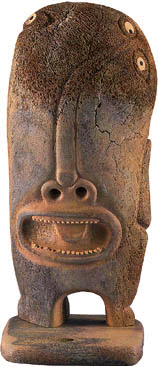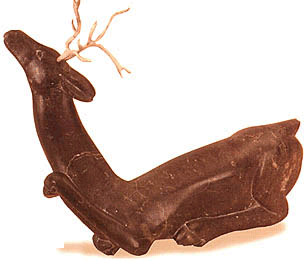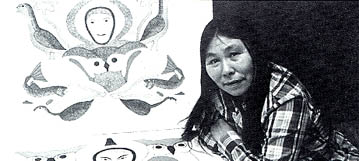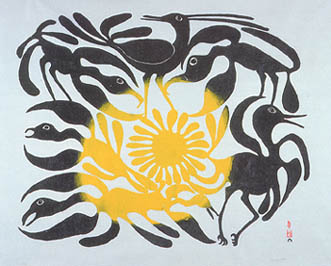INUIT ART
Responding to a Spiritual World
In less than fifty years, contemporary Inuit art has
progressed from a welfare experiment to an internationally acclaimed symbol of Canadian
culture.
Canadian Inuit art has humble and surprisingly recent
beginnings. The notion that it is the culmination of thousands of years of artistic
development is somewhat of a myth. The prehistoric Dorset culture (500 B.C.–1000
A.D.), which produced ruggedly expressionistic animal and human figures in ivory, bone,
wood, and antler for magico-religious reasons, was probably wiped out by a wave of
immigrants from Alaska around 1000 A.D. The art of this more recent Thule culture included
some amulets and ritual carvings but concentrated more on the decorative embellishment of
utilitarian objects.
 |
John Tiktak's timeless stone
figures and heads were shown in the first one-man public exhibition of Inuit art in 1970.
"Man" (1965) illustrated here is now part of the national collection at Ottawa's
Canadian Museum of Civilization [Canadian Museum of Civilization courtesy, the estate of
John Tiktak] |
The Thule are true ancestors of Canada’s
Inuit, but their culture was disrupted by the Little Ice Age of the sixteenth century and
the simultaneous arrival of Europeans in the Arctic. Art produced from the late eighteenth
to the mid-twentieth century (known as Historic Period art) was based on declining Thule
traditions but quickly adapted itself to the tastes of Europeans — explorers,
traders, whalers and missionaries. Primarily a souvenir art, it illustrated Arctic themes
and subjects but also created miniature replicas of European items. Non-traditional
objects such as cribbage boards and cigarette boxes, exquisitely fashioned in ivory, were
eagerly traded for tobacco, guns, and other goods.
  |
| 1.From Taloyoak (Spence Bay),
Karoo Ashevak's brilliant surrealistic whalebone compositions, such as "Whalebone
Face," 1974, won international acclaim before his tragic death [Canadian Museum of
Civilization courtesy, the estate of Karoo Ashevak] 2. Osuitok Ipeelee's elegantly sculpted
caribou and birds have earned him the medal of the Royal Canadian Academy. "Kneeling
Caribou," 1970, represents the best of Cape Dorest craftmanship and is part of the
permanent collection of the Canadian Museum of Civilization. [Reproduced with permission,
West Baffin Eskimo Cooperative] |
The birth of the Contemporary Period of Inuit art can be
precisely dated to 1949 because of an historic exhibition and sale of Inuit art held at
the Canadian Guild of Crafts in Montreal that year. James Houston, a young Toronto artist,
had visited Arctic Quebec the previous summer and excitedly showed the Guild the carvings
he had purchased. The Guild sponsored a buying trip for Houston. The hundreds of carvings
he purchased sold out in three days! The Hudson’s Bay Company, the Federal
government, and the northern cooperative movement all encouraged art production across the
Canadian Arctic. Initially the Federal government viewed art production as a means to
supplement welfare payments to Inuit.

|
Jessie Oonark, from Baker Lake, sewed boldly
coloured, hieratic images into wallhangings. "Untitled" was crafted 1973/74, and
is hanging in the permanent collection of Ottawa's National Gallery. (National Gallery of
Canada/courtsey the estate of Jessie Oonark) |
Carvings from the early 1950s were somewhat tentative and
naive in conception, but changes occurred rapidly. Stone replaced ivory as the preferred
material; consequently, sculptures grew in scale and complexity. Today, carvers work in a
wide variety of stone types as well as in ivory, antler, and whalebone. Regional and
community differences flourish, and Arctic Quebec realism, Cape Dorset stylized
naturalism, Keewatin abstraction, and Central Arctic expressionism have become stylistic
“schools” of Inuit sculpture.
Drawing and printmaking (Southern art concepts first
introduced in Cape Dorset in 1957) were quickly and masterfully adapted by Inuit artists.
Graphic art programs spread to Povungnituk, Holman, Baker Lake and Pangnirtung.
Pangnirtung also became famous for its woven tapestries, Baker Lake for its appliqué wall
hangings.
As individual artists gained confidence and
skill, many became stars in the Southern art world. John Tiktak’s timeless stone
figures and heads were shown in the first one-man public exhibition of Inuit art in 1970.
Osuitok Ipeelee’s elegantly sculpted caribou and birds have earned him the medal of
the Royal Canadian Academy. Kenojuak Ashevak’s celebrated print “Enchanted
Owl,” has become an icon of Inuit art. Jessie Oonark sewed her boldly coloured,
hieratic images into wall hangings; others translated her drawings into prints. Karoo
Ashevak’s brilliant surrealistic whalebone compositions won him international acclaim
in the four short years before his tragic death.
 |
| Kenojuak Ashevak, from Cape
Dorset, is recognized worldwide for her colourful prints, primarily of birds,
characterized by a strong sense of composition, colour, design and draughtsmanship.
[NAC/PA/140297] |
That such a small population (30,000), so thinly spread
across the Canadian Arctic, has produced such a richly diverse art is a testament to the
talent and ingenuity of Inuit. Within the constraints of a severe climate, chronic
shortages of raw materials, economic forces beyond their control, and (until recently)
primitive tools, Inuit artists have created works which are eagerly sought by collectors
and public institutions in Canada and abroad. The production of art is not only a major
economic force in the North but also has become a source of cultural identity and pride
for the Inuit and Canadians as a whole. Both at home and abroad, Inuit sculptures and
prints are probably more closely identified with Canada than even the paintings of the
Group of Seven.
Perhaps no other art form can boast such wide
popularity. The secret of Inuit art’s success is its ability to strike a responsive
chord in almost anyone from the museum curator or art collector to the average person
looking for a souvenir or gift. There is something for everyone, in almost any price
range. Inuit art is refreshingly straightforward in a world where much art is political,
elitist, or difficult to appreciate in aesthetic terms.
 |
Kenojuak Ashevak's hunting print,
"Arrival of the Sun," 1962, is part of the permanent collection of the Canadian
Museum of Civilization. [West Baffin Eskimo Cooperative] |
Contemporary Inuit art is one of those happy accidents of
history. Essentially an acculturated art form prompted by outsiders, Inuit art has
nonetheless captured the essence of Inuit spirituality and strength. Inuit artists have
immortalized their traditional culture through their work and in the process have
preserved their culture and values for their grandchildren. But as their traditional
customs and lifestyle become only memories, will Inuit artists be able to rely on
nostalgic themes and subjects or will they explore new paths? The future of Inuit art is
uncertain, but its achievements to date will be a source of pride for Inuit and Canadians
for all time.






